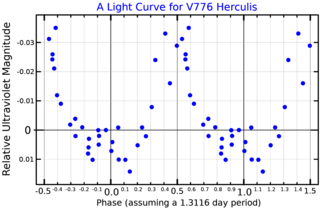
Subrahmanyan Chandrasekhar was an Indian-American theoretical physicist who made significant contributions to understanding of stellar evolution, black holes, and the structure of stars. He was awarded the 1983 Nobel Prize in physics along with William A. Fowler for "...theoretical studies of the physical processes of importance to the structure and evolution of the stars". His mathematical treatment of stellar evolution yielded many of the current theoretical models of the later evolutionary stages of massive stars and black holes. Many concepts, institutions, and inventions, including the Chandrasekhar limit and the Chandra X-Ray Observatory, are named after him.

Gamma Trianguli Australis, Latinized from γ Trianguli Australis, is a single, white-hued star in the southern constellation of Triangulum Australe. Along with Alpha and Beta Trianguli Australis it forms a prominent triangular asterism that gives the constellation its name. It is the third-brightest member of this constellation with an apparent visual magnitude of +2.87. Based upon parallax measurements, Gamma Trianguli Australis is located at a distance of about 184 light-years from Earth.
109 Virginis is a single, white-hued star in the zodiac constellation of Virgo, located some 134.5 light years away from the Sun. It is the seventh-brightest member of this constellation, having an apparent visual magnitude of +3.72.

Xi Virginis is a solitary star in the zodiac constellation of Virgo. It is bright enough to be seen with the naked eye, having an apparent visual magnitude of 4.83. The distance to this star is about 122 light years, as determined from parallax readings.

108 Aquarii is a star in the equatorial constellation of Aquarius. 108 Aquarii is the Flamsteed designation, although it also bears the Bayer designation i3 Aquarii and the variable star designation ET Aquarii. It has an apparent visual magnitude of 5.194 and can be seen with the naked eye under suitably dark skies. Based upon an annual parallax shift of 10.23, the distance to this star is 319 light-years.

15 Cancri is an α2 CVn-type variable star in the zodiac constellation of Cancer, located around 980 light years away. It has the variable star designation BM Cancri ; 15 Cancri is the Flamsteed designation. This system is visible to the naked eye as a faint, white-hued star with an apparent visual magnitude of about 5.6. It is moving away from the Earth with a heliocentric radial velocity of 25 km/s.

Pi Cassiopeiae, Latinized from π Cassiopeiae, is a close binary star system in the constellation Cassiopeia. It is visible to the naked eye with an apparent visual magnitude of +4.949. Based upon an annual parallax shift of 18.63 mas as seen from Earth, this system is located about 175 light years from the Sun.
16 Lyrae is a suspected astrometric binary star system in the constellation Lyra, located 126 light years away from the Sun based on parallax. It is visible to the naked eye as a dim, white-hued star with a combined apparent visual magnitude of 5.00. The system is moving further away from the Earth with a heliocentric radial velocity of +5 km/s. It is a suspected member of the Ursa Major Moving Group stream.
HD 191984 is a double star in the equatorial constellation of Aquila. As of 2011, the components have an angular separation of 2.52″ along a position angle of 205.7°.
HR 3082 is a double star in the northern circumpolar constellation of Camelopardalis. It is faintly visible to the naked eye with an apparent visual magnitude of 5.39. The system is moving closer to the Sun with a heliocentric radial velocity of +2.7 km/s. It is currently at a distance of around 323 light years, based upon an annual parallax shift of 10.10±0.24 mas.

21 Vulpeculae is a single, white-hued star in the northern constellation of Vulpecula. Its distance can be estimated from the annual parallax shift of 10.4302±0.0696 mas, yielding a separation of 313 light years. The star is faintly visible to the naked eye at night, having an apparent visual magnitude of 5.19. It is moving further away with a heliocentric radial velocity of about +7 km/s, having come within 243 ly (74.53 pc) around 4.2 million years ago.

45 Herculis is a solitary variable star in the northern constellation Hercules. It has the Bayer designation l Herculis and the variable star designation V776 Herculis. The Flamsteed designation for this star comes from the publication Historia Coelestis Britannica by John Flamsteed. It is the 45th star in Flamsteed list of stars in the constellation Hercules, and is visible to the naked eye with a baseline apparent visual magnitude of 5.22. Parallax measurements show this star to be about 400 light-years away from the Solar System. It is moving closer to the Earth with a heliocentric radial velocity of −16 km/s.
38 Geminorum is a binary star system in the northern zodiac constellation of Gemini. It has the Bayer designation e Geminorum, while 38 Geminorum is the Flamsteed designation. This system is visible to the naked eye as a faint, white-hued point of light with an apparent visual magnitude of 4.71. The primary component is a magnitude 4.75 star, while the secondary is magnitude 7.80. The system is located about 98 light years away from the Sun based on parallax, and is drifting further away with a radial velocity of +16 km/s. It is a potential member of the Tucana–Horologium stellar kinematic group.

Iota Delphini is a star in the constellation Delphinus. It has an apparent magnitude of about 5.4, meaning that it is just barely visible to the naked eye. Based upon parallax measurements made by the Gaia spacecraft, this star is located at a distance of 196 light years.
Tau7 Eridani is a solitary star in the constellation Eridanus. It is visible to the naked eye with an apparent visual magnitude of 5.235. Using the parallax method, the distance to this star can be estimated as around 251 light years.

1 Delphini is the Flamsteed designation for a close binary star in the equatorial constellation Delphinus. With a combined apparent magnitude of 6.08, it is barely visible to the naked eye, even under ideal conditions. Parallax measurements put the components at a distance 703 and 780 light years respectively. However, its approaching the Solar System with a radial velocity of 15 km/s.
John Craig Wheeler is an American astronomer. He is the Samuel T. and Fern Yanagisawa Regents Professor of Astronomy Emeritus at the University of Texas at Austin. He is known for his theoretical work on supernovae. He is a past president of the American Astronomical Society, a Fellow of that society, and a Fellow of the American Physical Society.
16 Delphini is a star in the equatorial constellation Delphinus. It has an apparent magnitude of 5.54, making it faintly visible to the naked eye. The star is relatively close at a distance of 198 light years but is receding with a poorly constrained radial velocity of 2 km/s.

23 Leonis Minoris is a solitary, bluish-white hued star located in the northern constellation Leo Minor. It is positioned 7° south and 11" west from β Leonis Minoris. It is rarely called 7 H. Leonis Minoris, which is its Hevelius designation.

HD 24141, also known as HR 1192, is a star located in the northern constellation Camelopardalis, the giraffe. It is faintly visible to the naked eye as a white-hued point of light with an apparent magnitude of 5.79. The object is located relatively close at a distance of 176 light-years based on Gaia DR3 parallax measurements and it is slowly drifting closer with a heliocentric radial velocity of −0.2 km/s. At its current distance, HD 24141's brightness is diminished by 0.17 magnitudes due to interstellar extinction and it has an absolute magnitude of +2.28.










